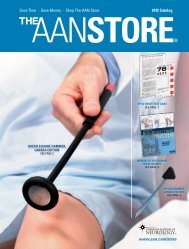Practice parameter: Evaluating a first nonfebrile seizure in children
Practice parameter: Evaluating a first nonfebrile seizure in children
Practice parameter: Evaluating a first nonfebrile seizure in children
Create successful ePaper yourself
Turn your PDF publications into a flip-book with our unique Google optimized e-Paper software.
Special Article<br />
CME <strong>Practice</strong> <strong>parameter</strong>: <strong>Evaluat<strong>in</strong>g</strong> a<br />
<strong>first</strong> <strong>nonfebrile</strong> <strong>seizure</strong> <strong>in</strong> <strong>children</strong><br />
Report of the Quality Standards Subcommittee of the<br />
American Academy of Neurology, the Child Neurology<br />
Society, and the American Epilepsy Society<br />
D. Hirtz, MD; S. Ashwal, MD; A. Berg, PhD; D. Bettis, MD; C. Camfield, MD; P. Camfield, MD;<br />
P. Crumr<strong>in</strong>e, MD; R. Elterman, MD; S. Schneider, MD; and S. Sh<strong>in</strong>nar, MD, PhD<br />
Article abstract—Objective: The Quality Standards Subcommittee of the American Academy of Neurology develops<br />
practice <strong>parameter</strong>s as strategies for patient management based on analysis of evidence. For this practice <strong>parameter</strong>, the<br />
authors reviewed available evidence on evaluation of the <strong>first</strong> <strong>nonfebrile</strong> <strong>seizure</strong> <strong>in</strong> <strong>children</strong> <strong>in</strong> order to make practice<br />
recommendations based on this available evidence. Methods: Multiple searches revealed relevant literature and each<br />
article was reviewed, abstracted, and classified. Recommendations were based on a three-tiered scheme of classification of<br />
the evidence. Results: Rout<strong>in</strong>e EEG as part of the diagnostic evaluation was recommended; other studies such as<br />
laboratory evaluations and neuroimag<strong>in</strong>g studies were recommended as based on specific cl<strong>in</strong>ical circumstances. Conclusions:<br />
Further studies are needed us<strong>in</strong>g large, well-characterized samples and standardized data collection <strong>in</strong>struments.<br />
Collection of data regard<strong>in</strong>g appropriate tim<strong>in</strong>g of evaluations would be important.<br />
NEUROLOGY 2000;55:616–623<br />
The Quality Standards Subcommittee (QSS) of the<br />
American Academy of Neurology (AAN) seeks to develop<br />
scientifically sound, cl<strong>in</strong>ically relevant practice<br />
<strong>parameter</strong>s for physicians for diagnostic procedures,<br />
treatment modalities, and cl<strong>in</strong>ical disorders. <strong>Practice</strong><br />
<strong>parameter</strong>s are strategies for patient management<br />
that might <strong>in</strong>clude diagnosis, symptom, treatment,<br />
or procedure evaluation. They consist of one or more<br />
specific recommendations based on the analysis of<br />
evidence.<br />
Every year, an estimated 25,000 to 40,000 US<br />
<strong>children</strong> experience their <strong>first</strong> <strong>nonfebrile</strong> <strong>seizure</strong>, a<br />
dramatic and frighten<strong>in</strong>g event. 1-4 This practice <strong>parameter</strong><br />
reviews available evidence concern<strong>in</strong>g the<br />
value of diagnostic test<strong>in</strong>g after a <strong>first</strong> <strong>nonfebrile</strong><br />
<strong>seizure</strong> <strong>in</strong> a child, and provides recommendations<br />
based on this evidence. It addresses the evaluation of<br />
<strong>children</strong> age 1 month to 21 years who have experienced<br />
a <strong>first</strong> <strong>nonfebrile</strong> <strong>seizure</strong> that cannot be ex-<br />
pla<strong>in</strong>ed by an immediate, obvious provok<strong>in</strong>g cause<br />
such as head trauma or <strong>in</strong>tracranial <strong>in</strong>fection. Reports<br />
concern<strong>in</strong>g serum laboratory studies, CSF exam<strong>in</strong>ation,<br />
EEG, CT, and MRI are reviewed. This<br />
<strong>parameter</strong> concerns diagnostic evaluation; a subsequent<br />
<strong>parameter</strong> will focus on treatment of the <strong>first</strong><br />
<strong>nonfebrile</strong> <strong>seizure</strong>.<br />
The <strong>seizure</strong> types covered by this <strong>parameter</strong> <strong>in</strong>clude<br />
partial (simple or complex partial, or partial<br />
with secondary generalization), generalized tonicclonic,<br />
or tonic <strong>seizure</strong>s. We are specifically not <strong>in</strong>clud<strong>in</strong>g<br />
<strong>children</strong> diagnosed with epilepsy, def<strong>in</strong>ed as<br />
two or more <strong>seizure</strong>s without acute provocation. For<br />
this reason, myoclonic and atonic <strong>seizure</strong>s are excluded<br />
because they typically are not recognized until<br />
there have been multiple occurrences. We def<strong>in</strong>ed<br />
the <strong>first</strong> <strong>seizure</strong> us<strong>in</strong>g the International League<br />
Aga<strong>in</strong>st Epilepsy (ILAE) criteria to <strong>in</strong>clude multiple<br />
<strong>seizure</strong>s with<strong>in</strong> 24 hours with recovery of conscious-<br />
From the National Institute of Neurological Disorders and Stroke (Dr. Hirtz), National Institutes of Health, Bethesda, MD; Department of Pediatrics (Dr.<br />
Ashwal), Loma L<strong>in</strong>da University School of Medic<strong>in</strong>e, Loma L<strong>in</strong>da, CA; Department of Biological Sciences (Dr. Berg), Northern Ill<strong>in</strong>ois University, Dekalb; Dr.<br />
David Bettis, Boise, ID; Department of Pediatric Neurology (Drs. C. Camfield and P. Camfield), IW Killam Hospital for Children, Halifax, Nova Scotia;<br />
Department of Neurology (Dr. Crumr<strong>in</strong>e), Children’s Hospital of Pittsburgh, PA; Dr. Roy Elterman, Dallas, TX; Dr. Sanford Schneider, Riverside, CA; and<br />
the Departments of Neurology and Pediatrics (Dr. Sh<strong>in</strong>nar), Montefiore Medical Center, Albert E<strong>in</strong>ste<strong>in</strong> College of Medic<strong>in</strong>e, Bronx, NY.<br />
Approved by the Quality Standards Subcommittee April 1, 2000. Approved by the <strong>Practice</strong> Committee May 3, 2000. Approved by the AAN Board of Directors<br />
June 9, 2000.<br />
Received September 27, 1999. Accepted <strong>in</strong> f<strong>in</strong>al form June 13, 2000.<br />
Address correspondence and repr<strong>in</strong>t requests to QSS, American Academy of Neurology, 1080 Montreal Avenue, St. Paul, MN 55116; phone: 800-879-1960<br />
616 Copyright © 2000 by AAN Enterprises, Inc.
ness between <strong>seizure</strong>s. 5 Children with significant<br />
head trauma immediately preced<strong>in</strong>g the <strong>seizure</strong> or<br />
those with previously diagnosed CNS <strong>in</strong>fection or<br />
tumor or other known acute precipitat<strong>in</strong>g causes are<br />
excluded. We excluded neonatal <strong>seizure</strong>s (�28 days),<br />
<strong>first</strong> <strong>seizure</strong>s last<strong>in</strong>g 30 m<strong>in</strong>utes or more (status epilepticus),<br />
and febrile <strong>seizure</strong>s, because these disorders<br />
are diagnostically and therapeutically different.<br />
The American Academy of Pediatrics has recently<br />
published recommendations for evaluation of <strong>children</strong><br />
with a <strong>first</strong> simple febrile <strong>seizure</strong>. 6<br />
Description of process. An <strong>in</strong>itial MEDLINE literature<br />
search was performed for relevant articles<br />
published from 1980 to August 1996, us<strong>in</strong>g the follow<strong>in</strong>g<br />
key words: epilepsy, <strong>seizure</strong>s, convulsions,<br />
magnetic resonance imag<strong>in</strong>g, computed tomography,<br />
electroencephalography, blood chemical analysis,<br />
neurological exam<strong>in</strong>ation, and diagnostic errors.<br />
Standard search procedures were used, and subhead<strong>in</strong>gs<br />
were applied as appropriate. In addition,<br />
the database provided by Current Contents was<br />
searched for the most recent 6-month period. These<br />
searches produced 279 titles of journal articles <strong>in</strong><br />
English, and 79 <strong>in</strong> non-English languages. An updated<br />
MEDLINE search was performed <strong>in</strong> June 1997<br />
and aga<strong>in</strong> <strong>in</strong> November 1998.<br />
Titles and abstracts were reviewed for content regard<strong>in</strong>g<br />
<strong>first</strong> <strong>nonfebrile</strong> <strong>seizure</strong>s <strong>in</strong> <strong>children</strong> and<br />
adults. Articles from the searches were identified for<br />
review and additional articles from the references <strong>in</strong><br />
these primary articles were <strong>in</strong>cluded. Articles were<br />
excluded if they conta<strong>in</strong>ed only data on adults with<br />
established epilepsy, but references were reviewed<br />
perta<strong>in</strong><strong>in</strong>g to adults with <strong>first</strong> <strong>seizure</strong>s only, to both<br />
<strong>children</strong> and adults with <strong>first</strong> <strong>seizure</strong>s, and to <strong>children</strong><br />
with both new and established <strong>seizure</strong>s. Two of<br />
the articles published <strong>in</strong> non-English languages met<br />
our criteria and were <strong>in</strong>cluded. Of the articles reviewed<br />
from searches, bibliographies, and committee<br />
member suggestions, 66 met the above criteria and<br />
were <strong>in</strong>cluded as references. The age ranges <strong>in</strong>cluded<br />
<strong>in</strong> the studies were variable, and most pediatric<br />
studies <strong>in</strong>cluded up to age 16 to 19 years. In most<br />
reports, results were not broken down accord<strong>in</strong>g to<br />
subsets of age groups.<br />
A new three-tiered scheme of classification of evidence<br />
was developed specifically to be used for evaluation<br />
of diagnostic studies (Appendix 1). This<br />
classification scheme was approved by the QSS of<br />
the AAN and differs from one that has been used for<br />
the assessment of treatment efficacy studies, which<br />
largely perta<strong>in</strong>s to randomized trials.<br />
Each of the selected articles was reviewed, abstracted,<br />
and classified by at least two reviewers.<br />
Abstracted data <strong>in</strong>cluded patient numbers, ages and<br />
gender, tim<strong>in</strong>g of subject selection (prospective, retrospective,<br />
or referral), case-f<strong>in</strong>d<strong>in</strong>g methods, exclusion<br />
criteria, <strong>seizure</strong> characteristics, neurologic<br />
abnormalities prior to or after the <strong>seizure</strong>, evalua-<br />
tions and results, and recommendations of the authors.<br />
Methods of data analysis were also noted.<br />
Goals of immediate evaluation. After stabilization<br />
of the child, a physician must determ<strong>in</strong>e if a<br />
<strong>seizure</strong> has occurred, and if so, if it is the child’s <strong>first</strong><br />
episode. It is critical to obta<strong>in</strong> as detailed a history<br />
as possible at the time of presentation. The determ<strong>in</strong>ation<br />
that a <strong>seizure</strong> has occurred is typically based<br />
on a detailed history provided by a reliable observer<br />
(Appendix 2). A careful history and neurologic exam<strong>in</strong>ation<br />
may allow a diagnosis without need for further<br />
evaluation. Children can present with <strong>seizure</strong>-like<br />
symptoms that may not <strong>in</strong> fact represent actual <strong>seizure</strong>s,<br />
but rather breath-hold<strong>in</strong>g spells, syncope,<br />
gastro–esophageal reflux, pseudo<strong>seizure</strong>s (psychogenic),<br />
and other nonepileptic events. No s<strong>in</strong>gle cl<strong>in</strong>ical<br />
symptom can reliably discrim<strong>in</strong>ate between a<br />
<strong>seizure</strong> and a nonepileptic event. 7,8 Studies have <strong>in</strong>vestigated<br />
whether serum prolact<strong>in</strong> levels 9,10 or creat<strong>in</strong>e<br />
k<strong>in</strong>ase levels 11 may help dist<strong>in</strong>guish <strong>seizure</strong>s<br />
from nonepileptic events, but neither of these tests is<br />
sufficiently reliable to use rout<strong>in</strong>ely.<br />
The next goal of assessment is to determ<strong>in</strong>e the<br />
cause of the <strong>seizure</strong>. In many <strong>children</strong>, the history<br />
and physical exam<strong>in</strong>ation alone will provide adequate<br />
<strong>in</strong>formation regard<strong>in</strong>g probable cause of the<br />
<strong>seizure</strong> 12 or the need for other tests <strong>in</strong>clud<strong>in</strong>g neuroimag<strong>in</strong>g.<br />
13 The etiology of the <strong>seizure</strong> may necessitate<br />
prompt treatment or provide important prognostic <strong>in</strong>formation.<br />
Provoked <strong>seizure</strong>s are the result of an acute<br />
condition such as hypoglycemia, toxic <strong>in</strong>gestion, <strong>in</strong>tracranial<br />
<strong>in</strong>fection, trauma, or other precipitat<strong>in</strong>g factors.<br />
Unprovoked <strong>seizure</strong>s occur <strong>in</strong> the absence of such factors;<br />
their etiology may be cryptogenic (no known<br />
cause), remote symptomatic (pre-exist<strong>in</strong>g bra<strong>in</strong> abnormality<br />
or <strong>in</strong>sult), or idiopathic (genetic).<br />
Laboratory studies. Evidence. In one Class I<br />
study of 30 <strong>children</strong> ages 0 to 18 years, and 133<br />
adults with <strong>seizure</strong>s, of whom 24 (15%) had new<br />
onset <strong>seizure</strong>s, the standard diagnostic laboratory<br />
workup, which <strong>in</strong>cluded complete blood count (CBC),<br />
serum electrolytes, blood urea nitrogen (BUN), creat<strong>in</strong><strong>in</strong>e,<br />
glucose, calcium, and magnesium, revealed<br />
one case of hyperglycemia that was unsuspected cl<strong>in</strong>ically<br />
14 (95% CI 0, 4.9%). This patient’s age was not<br />
noted, nor were those with new onset <strong>seizure</strong>s identified<br />
by age. Another prospective study of 136 new<br />
onset <strong>seizure</strong> patients found no cl<strong>in</strong>ically significant<br />
laboratory abnormalities <strong>in</strong> the 16 <strong>children</strong> <strong>in</strong> the<br />
study who were ages 12 to 19 years 15 (95% CI 0, 19%).<br />
In two Class II studies <strong>in</strong>clud<strong>in</strong>g 507 <strong>children</strong><br />
with both febrile and <strong>nonfebrile</strong> <strong>seizure</strong>s, results of<br />
laboratory studies did not contribute to diagnosis or<br />
management. 12,16 In another Class II study <strong>in</strong>clud<strong>in</strong>g<br />
65 <strong>children</strong> with new onset <strong>seizure</strong>s not accompanied<br />
by fever, one had a positive coca<strong>in</strong>e screen, and<br />
seven had electrolyte abnormalities (additional data<br />
supplied by the author of reference 17). Of these,<br />
four <strong>children</strong> were hyponatremic and three were hy-<br />
September (1 of 2) 2000 NEUROLOGY 55 617
pocalcemic. Of the four <strong>children</strong> with hyponatremia,<br />
three had a history of illness, lethargy, or diarrhea,<br />
and one had no specific symptoms. Of the three with<br />
hypocalcemia, one (age 4 months) had cl<strong>in</strong>ical signs<br />
of rickets, one (age 1 month) had multiple <strong>seizure</strong>s,<br />
and one (age 5 years) had a prolonged focal <strong>seizure</strong>.<br />
An exception to the small number of abnormal laboratory<br />
f<strong>in</strong>d<strong>in</strong>gs <strong>in</strong> the absence of specific suggestive<br />
features is <strong>in</strong> the under 6 month age group. Hyponatremia<br />
(�125 mM/L) was found to be associated with<br />
<strong>seizure</strong>s <strong>in</strong> 70% of 47 <strong>in</strong>fants younger than 6 months<br />
<strong>in</strong> a Class II study. 18<br />
In a sample of 56 <strong>children</strong> with a <strong>first</strong> <strong>seizure</strong>, 40<br />
of whom were febrile, there was one positive ur<strong>in</strong>e<br />
toxicology screen of the 11 performed. None of 53<br />
hematology tests (95% CI 0, 6%) and two of 96 (2%)<br />
chemistry tests were found to be cl<strong>in</strong>ically significant<br />
(both hyponatremia) (95% CI 0, 11%). 19 In three<br />
studies that <strong>in</strong>cluded a total of 400 adults, 19-21 only<br />
27 (�7%) were found to have abnormalities of calcium,<br />
sodium, glucose, BUN, or arterial blood gas<br />
(ABG) determ<strong>in</strong>ations. Of these abnormalities, only<br />
three were unsuspected on a cl<strong>in</strong>ical basis.<br />
Conclusions. The fact that a <strong>first</strong> <strong>nonfebrile</strong> <strong>seizure</strong><br />
occurred <strong>in</strong> the absence of any suggestive history<br />
or symptoms <strong>in</strong> a child who is older than age 6<br />
months and has returned to basel<strong>in</strong>e has not been<br />
shown to be sufficient reason to perform rout<strong>in</strong>e laboratory<br />
test<strong>in</strong>g <strong>in</strong> the child with a <strong>first</strong> <strong>nonfebrile</strong><br />
<strong>seizure</strong>. However, the number of <strong>children</strong> reported is<br />
too small to be confident that <strong>in</strong> rare circumstances,<br />
rout<strong>in</strong>e laboratory screen<strong>in</strong>g such as blood glucose<br />
determ<strong>in</strong>ation 12,15,16 might not provide important <strong>in</strong>formation,<br />
even without specific cl<strong>in</strong>ical <strong>in</strong>dications.<br />
There were only two reports of positive toxicology<br />
screens, but no studies that systematically evaluated<br />
the yield from do<strong>in</strong>g rout<strong>in</strong>e toxicology screen<strong>in</strong>g <strong>in</strong><br />
<strong>children</strong> with <strong>first</strong> <strong>seizure</strong>s. If no cause for the <strong>seizure</strong><br />
has been identified, it is important to ask questions<br />
regard<strong>in</strong>g possible toxic <strong>in</strong>gestions or exposures. 20<br />
Recommendations.<br />
• Laboratory tests should be ordered based on <strong>in</strong>dividual<br />
cl<strong>in</strong>ical circumstances that <strong>in</strong>clude suggestive<br />
historic or cl<strong>in</strong>ical f<strong>in</strong>d<strong>in</strong>gs such as vomit<strong>in</strong>g,<br />
diarrhea, dehydration, or failure to return to basel<strong>in</strong>e<br />
alertness. 12,14,15,20 (Option)<br />
• Toxicology screen<strong>in</strong>g should be considered across<br />
the entire pediatric age range if there is any question<br />
of drug exposure or substance abuse. (Option)<br />
Lumbar puncture. Evidence. Lumbar puncture<br />
(LP) is frequently performed <strong>in</strong> <strong>children</strong> <strong>in</strong> the presence<br />
of fever and <strong>seizure</strong>s to rule out CNS <strong>in</strong>fection.<br />
6,21,22 In the only report found giv<strong>in</strong>g the<br />
frequency of positive sp<strong>in</strong>al fluid exam<strong>in</strong>ations <strong>in</strong><br />
<strong>children</strong> with <strong>nonfebrile</strong> <strong>seizure</strong>s, of 57 sp<strong>in</strong>al fluid<br />
samples <strong>in</strong> <strong>children</strong> ages 2 to 24 months follow<strong>in</strong>g<br />
<strong>nonfebrile</strong> <strong>seizure</strong>s, 12.3% had �5 leukocytes/mm 3 <strong>in</strong><br />
the CSF. 23 These <strong>children</strong> did not have CNS <strong>in</strong>fec-<br />
618 NEUROLOGY 55 September (1 of 2) 2000<br />
tion. CSF glucose <strong>in</strong>creased with <strong>seizure</strong> duration<br />
and the range of CSF glucose was 32 to 130 mg/dL;<br />
the range of CSF prote<strong>in</strong> was 9 to 115 mg/dL. 23 A<br />
1993 AAN practice <strong>parameter</strong> regard<strong>in</strong>g the value of<br />
LP did not mention <strong>nonfebrile</strong> <strong>seizure</strong> as an <strong>in</strong>dication<br />
for LP <strong>in</strong> either <strong>children</strong> or adults. 21<br />
Conclusions. There is no evidence regard<strong>in</strong>g the<br />
yield of rout<strong>in</strong>e LP follow<strong>in</strong>g a <strong>first</strong> <strong>nonfebrile</strong> <strong>seizure</strong>.<br />
The one study available (Class II) is limited <strong>in</strong><br />
size and age range. Recommendations based on age<br />
and cl<strong>in</strong>ical symptoms are available from Class III<br />
publications. In the very young child (�6 months), <strong>in</strong><br />
the child of any age with persistent (cause unknown)<br />
alteration of mental status or failure to return to<br />
basel<strong>in</strong>e, or <strong>in</strong> any child with men<strong>in</strong>geal signs, LP<br />
should be performed. 6,21,22 If <strong>in</strong>creased <strong>in</strong>tracranial<br />
pressure is suspected, the LP should be preceded by<br />
an imag<strong>in</strong>g study of the head. 20<br />
Recommendations.<br />
• In the child with a <strong>first</strong> <strong>nonfebrile</strong> <strong>seizure</strong>, LP is of<br />
limited value and should be used primarily when<br />
there is concern about possible men<strong>in</strong>gitis or encephalitis.<br />
(Option)<br />
EEG. Evidence. Of 10 Class I studies reviewed 24-34<br />
(references 26 and 27 were from the same study) and<br />
one meta analysis, 35 five studies addressed the prognostic<br />
value of EEG <strong>in</strong> a population of <strong>children</strong> with<br />
a <strong>first</strong> <strong>seizure</strong>. 25-27,30,32,33 In four of these studies, epileptiform<br />
discharges or focal slow<strong>in</strong>g on the EEG<br />
were predictive of recurrence. 25,27,32,33 In <strong>children</strong> with<br />
a cryptogenic (cause unknown) <strong>first</strong> <strong>seizure</strong>, 54% of<br />
103 <strong>children</strong> with an abnormal EEG had a recurrence<br />
compared with 25% of 165 <strong>children</strong> with a<br />
normal EEG ( p � 0.001). 27 EEG abnormalities were<br />
reported to be the best predictors of recurrence <strong>in</strong><br />
<strong>children</strong> who were neurologically normal; however,<br />
abnormal neurologic exam<strong>in</strong>ation 25,26 and etiology 26,36<br />
were also strong predictors of recurrence. Several of<br />
these studies <strong>in</strong>dicated that the <strong>in</strong>formation provided<br />
by the EEG is useful for diagnosis of the event,<br />
identification of a specific syndrome, and prediction<br />
of long-term outcome. 26,27,32,33<br />
Of the four Class I studies of <strong>first</strong> <strong>seizure</strong>s <strong>in</strong><br />
adults only, or <strong>in</strong> both <strong>children</strong> and adults, an abnormal<br />
EEG was predictive for recurrence risk <strong>in</strong> three<br />
studies. 28,29,34 Inclusion of both an awake and a sleep<br />
trac<strong>in</strong>g, as well as hyperventilation and photic<br />
stimulation, 27,31,32,37-39 are recommended by the American<br />
EEG Society, 38 as they <strong>in</strong>crease the yield of abnormalities<br />
seen on EEG trac<strong>in</strong>gs.<br />
A Class I study published <strong>in</strong> 1998 <strong>in</strong> <strong>children</strong> and<br />
adults concluded that an EEG obta<strong>in</strong>ed with<strong>in</strong> 24<br />
hours of a <strong>seizure</strong> was more likely to conta<strong>in</strong> epileptiform<br />
abnormalities than one done later (51% versus<br />
34%). 34 The value of an EEG performed <strong>in</strong> the<br />
emergency department shortly after a <strong>seizure</strong> was<br />
addressed <strong>in</strong> two Class II studies of adult <strong>first</strong> sei-
zure patients. 40,41 In these studies, <strong>in</strong>terpretation<br />
was difficult <strong>in</strong> the presence of diffuse postictal slow<strong>in</strong>g,<br />
42 and an EEG done at that time was not helpful<br />
<strong>in</strong> determ<strong>in</strong><strong>in</strong>g which patients should be admitted to<br />
the hospital. 40<br />
A recent analysis of selected f<strong>in</strong>d<strong>in</strong>gs from several<br />
of the Class I studies referred to above 25-27,30,31 concluded<br />
that an EEG should not be rout<strong>in</strong>ely performed<br />
after a <strong>first</strong> <strong>seizure</strong> because it does not yield<br />
sufficient <strong>in</strong>formation to alter treatment decisions. 43<br />
To reach this conclusion, the authors did not consider<br />
evidence that the EEG result does <strong>in</strong> fact alter<br />
treatment decisions. They assumed a treatment<br />
threshold to be at an 80% risk of recurrence, and<br />
used a univariate analysis. However, where the EEG<br />
is used as one of several variables, it can identify<br />
<strong>children</strong> with very high and very low recurrence<br />
risks. 25,26,32,35 The EEG is not used solely to determ<strong>in</strong>e<br />
recurrence, but also helps differentiate a <strong>seizure</strong><br />
from other events, is essential to the diagnosis of a<br />
syndrome, and provides <strong>in</strong>formation on long-term<br />
prognosis; it <strong>in</strong>fluences the decision to perform subsequent<br />
neuroimag<strong>in</strong>g studies 44 and may <strong>in</strong>fluence<br />
counsel<strong>in</strong>g about management of the child.<br />
Conclusions. The majority of evidence from Class<br />
I and Class II studies confirms that an EEG helps <strong>in</strong><br />
determ<strong>in</strong>ation of <strong>seizure</strong> type, epilepsy syndrome,<br />
and risk for recurrence, and therefore may affect<br />
further management decisions. Experts commonly<br />
recommend that an EEG be performed after all <strong>first</strong><br />
<strong>nonfebrile</strong> <strong>seizure</strong>s. 39,45-47 It is not clear what the optimal<br />
tim<strong>in</strong>g should be for obta<strong>in</strong><strong>in</strong>g an EEG. Although<br />
an EEG done with<strong>in</strong> 24 hours of the <strong>seizure</strong><br />
is most likely to show abnormalities, 34 physicians<br />
should be aware that some abnormalities such as<br />
postictal slow<strong>in</strong>g that can be seen on EEG done<br />
with<strong>in</strong> 24 to 48 hours of a <strong>seizure</strong> may be transient<br />
and must be <strong>in</strong>terpreted with caution.<br />
There is no evidence that the EEG must be done<br />
before discharge from the emergency department;<br />
the study may be arranged on an outpatient basis.<br />
Epileptiform EEG abnormalities may be useful <strong>in</strong><br />
confirm<strong>in</strong>g that the event was a <strong>seizure</strong>; however, an<br />
EEG abnormality by itself is not sufficient to make a<br />
diagnosis that an epileptic <strong>seizure</strong> occurred, nor can<br />
its absence rule out a <strong>seizure</strong>. 46,47 The EEG is necessary<br />
to determ<strong>in</strong>e the epilepsy syndrome and the<br />
diagnosis of an epilepsy syndrome may be helpful <strong>in</strong><br />
determ<strong>in</strong><strong>in</strong>g the need for imag<strong>in</strong>g studies. 34 The EEG<br />
is also useful <strong>in</strong> predict<strong>in</strong>g the prognosis for<br />
recurrences. 20,39,45-47<br />
It is not clear what the optimal tim<strong>in</strong>g should be<br />
for obta<strong>in</strong><strong>in</strong>g an EEG. Although an EEG done with<strong>in</strong><br />
24 hours of the <strong>seizure</strong> is most likely to show abnormalities,<br />
physicians should be aware that some abnormalities<br />
such as postictal slow<strong>in</strong>g that can be<br />
seen on EEG done with<strong>in</strong> 24 to 48 hours of a <strong>seizure</strong><br />
may be transient and must be <strong>in</strong>terpreted with<br />
caution.<br />
Recommendations.<br />
• The EEG is recommended as part of the neurodiagnostic<br />
evaluation of the child with an apparent<br />
<strong>first</strong> unprovoked <strong>seizure</strong>. (Standard)<br />
Neuroimag<strong>in</strong>g studies. Evidence—CT scans.<br />
There were five Class I studies regard<strong>in</strong>g imag<strong>in</strong>g by<br />
CT scan after a <strong>first</strong> <strong>seizure</strong>; the data perta<strong>in</strong>ed to<br />
<strong>children</strong> 32 and adults 24,42,48 with <strong>first</strong> <strong>seizure</strong>s, and to<br />
adults and <strong>children</strong> over age 6 with both new onset<br />
and established <strong>seizure</strong>s. 14 In the s<strong>in</strong>gle Class I<br />
study of <strong>first</strong> <strong>seizure</strong>s <strong>in</strong> <strong>children</strong>, the abnormalities<br />
(mostly atrophy) found <strong>in</strong> 12 <strong>children</strong> were “without<br />
therapeutic consequences” (95% CI 0, 3%). 32 In one of<br />
the adult studies, 1.3% of the patients who had CT<br />
scans were diagnosed with tumors, 24 and <strong>in</strong> another,<br />
of 62 patients there were three tumors seen on CT,<br />
all <strong>in</strong> patients with abnormal neurologic exam<strong>in</strong>ations.<br />
42 Of 119 adults who had CT scans after a <strong>first</strong><br />
generalized <strong>seizure</strong>, 20 had abnormalities that warranted<br />
therapeutic <strong>in</strong>tervention. 48 In the Class I<br />
study <strong>in</strong> which 19 CT scans were done <strong>in</strong> selective<br />
cases (<strong>first</strong> <strong>seizure</strong>s if greater than age 6 years, head<br />
trauma, or focal <strong>seizure</strong>), there was one significant<br />
abnormality (age of the patient was not given), a<br />
subdural hematoma, not predicted by history and<br />
physical exam<strong>in</strong>ation. 14<br />
Of the 14 Class II studies, n<strong>in</strong>e <strong>in</strong>volved <strong>children</strong><br />
only (n � 2559), 17,19,49-56 four were of adults only (n �<br />
666), 24,42,57,58 and one <strong>in</strong>volved <strong>children</strong> and adults<br />
(n � 109). 59 Only a small percentage of <strong>children</strong> <strong>in</strong><br />
these studies (0 to 7%) had lesions on CT that altered<br />
or <strong>in</strong>fluenced management. These were most<br />
commonly bra<strong>in</strong> tumors, communicat<strong>in</strong>g or obstructive<br />
hydrocephalus, one subarachnoid and one porencephalic<br />
cyst, and three <strong>children</strong> with cysticercosis.<br />
The yield of abnormality on CT when the neurologic<br />
exam<strong>in</strong>ation and EEG were normal was 5 to 10%. 50,54<br />
In a Class II study <strong>in</strong> which seven <strong>children</strong> (14% of<br />
<strong>children</strong> with <strong>nonfebrile</strong> <strong>seizure</strong>s) had CT scans that<br />
<strong>in</strong>fluenced management, five had focal or complex<br />
partial <strong>seizure</strong>s. Abnormalities on neuroimag<strong>in</strong>g<br />
were associated with a higher recurrence risk. 54 In<br />
one study of febrile and <strong>nonfebrile</strong> <strong>children</strong>, CT<br />
scans were always normal <strong>in</strong> the absence of def<strong>in</strong>ed<br />
risk factors such as known neurologic diagnosis,<br />
age �5 months, or focal deficit. 57 Focal lesions on<br />
CT scans tended to be more commonly found <strong>in</strong><br />
adults (18 to 34%) 40,48,57,58 than <strong>in</strong> <strong>children</strong> (0 to<br />
12%), 17,32,49,52,54-56 particularly when ordered for specific<br />
cl<strong>in</strong>ical <strong>in</strong>dications. At least three studies provided<br />
evidence that MRI scann<strong>in</strong>g was preferable to<br />
CT 51,54,60 <strong>in</strong> <strong>children</strong> follow<strong>in</strong>g <strong>nonfebrile</strong> <strong>seizure</strong>s.<br />
Evidence—MRI. There was one Class I report regard<strong>in</strong>g<br />
MRI <strong>in</strong> <strong>children</strong> present<strong>in</strong>g with a <strong>first</strong> <strong>seizure</strong><br />
54 and another Class I report of newly diagnosed<br />
epilepsy <strong>in</strong> <strong>children</strong>. 60 Of 411 <strong>children</strong> who presented<br />
with a <strong>first</strong> <strong>seizure</strong>, 218 had neuroimag<strong>in</strong>g studies.<br />
Four had lesions seen on MRI or CT (two bra<strong>in</strong> tumors,<br />
two neurocysticercosis) that potentially altered<br />
September (1 of 2) 2000 NEUROLOGY 55 619
Table Class I and II neuroimag<strong>in</strong>g studies <strong>in</strong> <strong>children</strong><br />
Reference<br />
No.<br />
<strong>children</strong> Ages Class Method<br />
management. 54 When these four were excluded, 407<br />
<strong>children</strong> rema<strong>in</strong>ed <strong>in</strong> this Class I study. Of these, 58<br />
<strong>children</strong> had an MRI scan, and 19 (33%) scans were<br />
abnormal, but none of the <strong>children</strong> required <strong>in</strong>tervention<br />
on the basis of the neuroimag<strong>in</strong>g f<strong>in</strong>d<strong>in</strong>gs. In<br />
the Class I study of 613 <strong>children</strong> with newly diagnosed<br />
epilepsy, 273 had partial, generalized tonic<br />
clonic, or generalized tonic <strong>seizure</strong>s and came to<br />
medical attention at the time of their <strong>first</strong> unprovoked<br />
<strong>seizure</strong> 60 (additional data supplied by the<br />
author of reference 60). Of these, 86% had neuroimag<strong>in</strong>g,<br />
and none had abnormalities <strong>in</strong>fluenc<strong>in</strong>g<br />
immediate treatment or management decisions. One<br />
Class I study of 300 adults and <strong>children</strong> with <strong>first</strong><br />
<strong>seizure</strong>s reported 43 MRI scans done <strong>in</strong> 59 <strong>children</strong>,<br />
one show<strong>in</strong>g hippocampal sclerosis and two show<strong>in</strong>g<br />
s<strong>in</strong>gle gray matter heterotopic nodules (additional<br />
data supplied by the author of reference 34). 34 All<br />
patients with generalized epilepsy had normal MRI<br />
scans. 34 In two Class II reports of retrospective evaluations<br />
of MRI <strong>in</strong> <strong>children</strong> with <strong>seizure</strong>s, one of<br />
which was limited to <strong>children</strong> with <strong>first</strong> <strong>seizure</strong>s<br />
only, abnormalities on MRI scan such as localized<br />
atrophy, mesial temporal sclerosis, and bra<strong>in</strong> malformation<br />
were common but did not mandate a change<br />
<strong>in</strong> management. 51,61 There were also six Class III<br />
reports. 39,46,62-65<br />
It was consistently reported <strong>in</strong> the literature cited<br />
above that the MRI was more sensitive than the CT<br />
scan. 39,51,54,60,62,63,65 MRI f<strong>in</strong>d<strong>in</strong>gs <strong>in</strong>cluded atrophy, <strong>in</strong>farction,<br />
evidence of trauma, cerebral dysgenesis,<br />
and cortical dysplasia. Authors of review articles<br />
also emphasized a preference for MRI to exclude<br />
progressive lesions such as tumors and vascular malformations,<br />
or focal cortical dysplasia. 39,62,63,65,66 Neuroimag<strong>in</strong>g<br />
was recommended if there is a postictal<br />
focal deficit not promptly resolv<strong>in</strong>g. 46,66 A recently<br />
published practice <strong>parameter</strong> on neuroimag<strong>in</strong>g <strong>in</strong><br />
the emergency patient present<strong>in</strong>g with <strong>seizure</strong>s reviewed<br />
literature primarily from adults but <strong>in</strong>cluded<br />
No.<br />
imaged<br />
No. abnormal<br />
(%)<br />
95% CI<br />
(%)<br />
No. significantly<br />
abnormal*<br />
(%)<br />
95% CI<br />
(%)<br />
Stro<strong>in</strong>k et al., 199832 156 1 mo to 16 y I CT 112 12 (11) 9–12 0 0–3<br />
Berg et al., 199960 † 273 1 mo to 15 y I MRI/CT 236 27 (11) 10–13 0 0–1<br />
K<strong>in</strong>g et al., 199834 † 59 5 to 16 y I MRI 43 3 (3.9) 0–2 0 0–7<br />
O’Dell et al., 199754 411 1 mo to 19 y I MRI/CT 218 44 (20) 18–22 4 (2) 2–2<br />
Gibbs et al., 199349 964 2 mo to 17 y II CT 121 26 (21) 18–24 2 (2) 1–2<br />
Yang et al., 197950 256 0 to 18 y II CT 256 84 (33) 30–36 7 (3) 2–3<br />
McAbee et al., 198952 81 1 mo to 18 y II CT 81 6 (7) 6–9 4 (5) 4–6<br />
Warden et al., 199756 158 Median 3.1 y II CT 158 10 (6) 5–7 0 0–2<br />
Garvey et al., 199817 65 2 wk to 16 y II CT 65 11 (17) 16–24 7 (11) 11–17<br />
Total 2423 1290 223 (17.3) 15–19 24 (1.9) 1–3<br />
* Influenc<strong>in</strong>g treatment or management decisions.<br />
† The author provided data regard<strong>in</strong>g analyses of the <strong>children</strong> who presented with a <strong>first</strong> <strong>nonfebrile</strong> <strong>seizure</strong>.<br />
620 NEUROLOGY 55 September (1 of 2) 2000<br />
<strong>children</strong>. This <strong>parameter</strong> recommended “emergent”<br />
neuroimag<strong>in</strong>g if there was suspicion of a serious structural<br />
lesion, and that “urgent” neuroimag<strong>in</strong>g should be<br />
considered if there was no clear cause of the <strong>seizure</strong>.<br />
This <strong>parameter</strong> states that if an emergent imag<strong>in</strong>g<br />
study is needed, it would be to detect hemorrhage,<br />
bra<strong>in</strong> swell<strong>in</strong>g, or mass effect, conditions that are typically<br />
adequately imaged on CT. 66 These recommendations<br />
were not restricted to any age bracket.<br />
Conclusions. Although abnormalities on neuroimag<strong>in</strong>g<br />
are seen <strong>in</strong> up to one third of <strong>children</strong> with a<br />
<strong>first</strong> <strong>seizure</strong>, most of these abnormalities do not <strong>in</strong>fluence<br />
treatment or management decisions such as<br />
the need for hospitalization or further studies (table).<br />
Of available reported imag<strong>in</strong>g results, from<br />
Class I and Class II studies of <strong>children</strong>, an average of<br />
about 2% revealed cl<strong>in</strong>ically significant f<strong>in</strong>d<strong>in</strong>gs that<br />
contributed to further cl<strong>in</strong>ical management, the majority<br />
of which were performed because the <strong>seizure</strong><br />
was focal or there were specific cl<strong>in</strong>ical f<strong>in</strong>d<strong>in</strong>gs beyond<br />
the fact that a <strong>seizure</strong> had occurred (see the<br />
table).<br />
Thus, there is <strong>in</strong>sufficient evidence to support a<br />
recommendation at the level of standard or guidel<strong>in</strong>e<br />
for the use of rout<strong>in</strong>e neuroimag<strong>in</strong>g, i.e., imag<strong>in</strong>g<br />
performed for which hav<strong>in</strong>g had a <strong>seizure</strong> is the sole<br />
<strong>in</strong>dication, after a <strong>first</strong> <strong>nonfebrile</strong> <strong>seizure</strong> <strong>in</strong> <strong>children</strong>.<br />
However, neuroimag<strong>in</strong>g may be <strong>in</strong>dicated under<br />
some circumstances either as an emergent or nonurgent<br />
procedure.<br />
The purpose of perform<strong>in</strong>g an emergent neuroimag<strong>in</strong>g<br />
study <strong>in</strong> the context of a child’s <strong>first</strong> <strong>seizure</strong> is<br />
to detect a serious condition that may require immediate<br />
<strong>in</strong>tervention. The possible effects of emergency<br />
medication used to treat the <strong>seizure</strong> must be taken<br />
<strong>in</strong>to consideration.<br />
The purpose of perform<strong>in</strong>g a nonurgent neuroimag<strong>in</strong>g<br />
study, which can be deferred to the next several<br />
days or later, is to detect abnormalities that<br />
may affect prognosis and therefore have an impact
on long-term treatment and management. 20,22 Factors<br />
to be considered <strong>in</strong>clude the age of the child, the<br />
need for sedation to perform the study, the EEG<br />
results, a history of head trauma, and other cl<strong>in</strong>ical<br />
circumstances such as a family history of epilepsy.<br />
Recommendations.<br />
• If a neuroimag<strong>in</strong>g study is obta<strong>in</strong>ed, MRI is the<br />
preferred modality. 50,51,54,60,62,63,65 (Guidel<strong>in</strong>e)<br />
Emergent neuroimag<strong>in</strong>g should be performed <strong>in</strong> a<br />
child of any age who exhibits a postictal focal deficit<br />
(Todd’s paresis) not quickly resolv<strong>in</strong>g, or who has not<br />
returned to basel<strong>in</strong>e with<strong>in</strong> several hours after the<br />
<strong>seizure</strong>. 46,66 (Option)<br />
• Nonurgent imag<strong>in</strong>g studies with MRI should be<br />
seriously considered <strong>in</strong> any child with a significant<br />
cognitive or motor impairment of unknown etiology,<br />
unexpla<strong>in</strong>ed abnormalities on neurologic exam<strong>in</strong>ation,<br />
a <strong>seizure</strong> of partial (focal) onset with or<br />
without secondary generalization, an EEG that<br />
does not represent a benign partial epilepsy of<br />
childhood or primary generalized epilepsy, or <strong>in</strong><br />
<strong>children</strong> under 1 year of age. 20,34 (Option)<br />
Summary. In the child with a <strong>first</strong> <strong>nonfebrile</strong> <strong>seizure</strong>,<br />
diagnostic evaluations <strong>in</strong>fluence therapeutic<br />
decisions, how families are counseled, and the need<br />
for hospital admission and/or specific follow-up<br />
plans. This practice <strong>parameter</strong> has reviewed the<br />
published literature concern<strong>in</strong>g the usefulness of<br />
studies follow<strong>in</strong>g a <strong>first</strong> <strong>nonfebrile</strong> <strong>seizure</strong> <strong>in</strong> <strong>children</strong>,<br />
and has classified the strength of the available<br />
evidence. There is sufficient Class I evidence, which<br />
<strong>in</strong>volves a well executed prospective study, to provide<br />
a recommendation with the highest degree of<br />
cl<strong>in</strong>ical certa<strong>in</strong>ty—i.e., a Standard—that an EEG be<br />
obta<strong>in</strong>ed <strong>in</strong> all <strong>children</strong> <strong>in</strong> whom a <strong>nonfebrile</strong> <strong>seizure</strong><br />
has been diagnosed, to predict the risk of recurrence<br />
and to classify the <strong>seizure</strong> type and epilepsy syndrome.<br />
The decision to perform other studies, <strong>in</strong>clud<strong>in</strong>g<br />
LP, laboratory tests, and neuroimag<strong>in</strong>g, for the<br />
purpose of determ<strong>in</strong><strong>in</strong>g the cause of the <strong>seizure</strong> and<br />
detect<strong>in</strong>g potentially treatable abnormalities, will<br />
depend on the age of the patient and the specific<br />
cl<strong>in</strong>ical circumstances. Children of different ages<br />
may require different management strategies. 20,22<br />
Future research. For most of the questions addressed<br />
by this <strong>parameter</strong>, evidence was <strong>in</strong>sufficient<br />
for mak<strong>in</strong>g a strong recommendation for a standard<br />
or guidel<strong>in</strong>e, particularly for laboratory studies. In<br />
order to generate def<strong>in</strong>itive evidence regard<strong>in</strong>g the<br />
value of rout<strong>in</strong>e (or selective) laboratory test<strong>in</strong>g and<br />
the use of rout<strong>in</strong>e neuroimag<strong>in</strong>g studies, sufficiently<br />
large samples allow<strong>in</strong>g for adequate statistical power<br />
to provide precise estimates (i.e., with narrow confidence<br />
<strong>in</strong>tervals) are needed. Neuroimag<strong>in</strong>g studies<br />
are needed to understand the significance of neuronal<br />
migration defects <strong>in</strong> the context of a <strong>first</strong> <strong>seizure</strong>,<br />
and are important because of the improved technical<br />
ability of current MRI. In addition, prospective collection<br />
of data us<strong>in</strong>g standardized treatment protocols<br />
and standardized data collection <strong>in</strong>struments is<br />
essential. Results of studies will only be helpful if<br />
the patient sample and factors that resulted <strong>in</strong> <strong>in</strong>clusion<br />
<strong>in</strong>to or exclusion from the sample are well described<br />
and documented. Ideally, large consecutive<br />
series of well-characterized patients are needed for<br />
the results to be accurate and generalizable. F<strong>in</strong>ally,<br />
future studies should present separate data from<br />
<strong>children</strong> and adults, and it would be optimal for results<br />
<strong>in</strong> <strong>children</strong> to be presented by age group<strong>in</strong>gs.<br />
Appropriate tim<strong>in</strong>g as well as the choice of evaluative<br />
studies have not been adequately studied. Children<br />
may present as actively hav<strong>in</strong>g a <strong>seizure</strong> when<br />
brought to the emergency department, as postictal,<br />
or as alert with a history of a possible <strong>seizure</strong> episode<br />
hav<strong>in</strong>g occurred hours, days, or weeks previously.<br />
Data regard<strong>in</strong>g the appropriate tim<strong>in</strong>g of<br />
laboratory test<strong>in</strong>g, neuroimag<strong>in</strong>g, or EEG studies require<br />
adequate prospective studies of these specific<br />
questions, with clearly def<strong>in</strong>ed entry criteria and a<br />
common protocol for type and tim<strong>in</strong>g of evaluations.<br />
Research studies with adequate sample sizes and<br />
appropriate protocols that provide answers to these<br />
questions may serve to reduce the expense and discomfort<br />
of unnecessary test<strong>in</strong>g <strong>in</strong> <strong>children</strong> with <strong>first</strong><br />
<strong>seizure</strong>s, and, more importantly, by identify<strong>in</strong>g appropriate<br />
candidates, may improve the care and<br />
management that these <strong>children</strong> receive.<br />
Disclaimer. This statement is provided as an educational<br />
service of the American Academy of Neurology.<br />
It is based on an assessment of current scientific<br />
and cl<strong>in</strong>ical <strong>in</strong>formation. It is not <strong>in</strong>tended to <strong>in</strong>clude<br />
all possible proper methods of care for a particular<br />
neurologic problem or all legitimate criteria for<br />
choos<strong>in</strong>g to use a specific procedure. Neither is it<br />
<strong>in</strong>tended to exclude any reasonable alternative<br />
methodologies. The AAN recognizes that specific patient<br />
care decisions are the prerogative of the patient<br />
and the physician car<strong>in</strong>g for the patient, based on all<br />
of the circumstances <strong>in</strong>volved.<br />
Acknowledgment<br />
The authors thank the members of the Quality Standards Subcommittee<br />
of the AAN, and Wendy Edlund, the AAN Cl<strong>in</strong>ical<br />
Policy Adm<strong>in</strong>istrator, for their time, expertise, and efforts <strong>in</strong> develop<strong>in</strong>g<br />
this document.<br />
Appendix 1<br />
Classification of evidence<br />
Class I. Must have all of a–d:<br />
a. Prospective study of a well def<strong>in</strong>ed cohort which <strong>in</strong>cludes a<br />
description of the nature of the population, the <strong>in</strong>clusion/exclusion<br />
criteria, demographic characteristics such as age and sex, and<br />
<strong>seizure</strong> type.<br />
b. The sample size must be adequate with enough statistical<br />
power to justify a conclusion or for identification of subgroups for<br />
whom test<strong>in</strong>g does or does not yield significant <strong>in</strong>formation.<br />
c. The <strong>in</strong>terpretation of evaluations performed must be done<br />
bl<strong>in</strong>ded to outcome.<br />
d. There must be a satisfactory description of the technology<br />
used for evaluations (e.g., EEG, MRI).<br />
September (1 of 2) 2000 NEUROLOGY 55 621
Class II. Must have a or b:<br />
a. A retrospective study of a well-def<strong>in</strong>ed cohort which otherwise<br />
meets criteria for Class 1a, 1b, and 1d.<br />
b. A prospective or retrospective study which lacks any of the<br />
follow<strong>in</strong>g: adequate sample size, adequate methodology, a description<br />
of <strong>in</strong>clusion/exclusion criteria, and <strong>in</strong>formation such as age,<br />
sex, and characteristics of the <strong>seizure</strong>.<br />
Class III. Must have a or b:<br />
a. A small cohort or case report.<br />
b. Relevant expert op<strong>in</strong>ion, consensus, or survey.<br />
A cost-benefit analysis or a meta-analysis may be Class I, II, or<br />
III, depend<strong>in</strong>g on the strength of the data upon which the analysis<br />
is based.<br />
Appendix 2<br />
Outl<strong>in</strong>e for <strong>seizure</strong> assessment<br />
Features of a <strong>seizure</strong>:<br />
Associated factors<br />
Age<br />
Family history<br />
Developmental status<br />
Behavior<br />
Health at <strong>seizure</strong> onset<br />
Precipitat<strong>in</strong>g events other than illness—trauma, tox<strong>in</strong>s<br />
Health at <strong>seizure</strong> onset—febrile, ill, exposed to illness, compla<strong>in</strong>ts<br />
of not feel<strong>in</strong>g well, sleep deprived<br />
Symptoms dur<strong>in</strong>g <strong>seizure</strong> (ictal)<br />
Aura: Subjective sensations<br />
Behavior: Mood or behavioral changes before the <strong>seizure</strong><br />
Preictal symptoms: Described by patient or witnessed<br />
Vocal: Cry or gasp, slurr<strong>in</strong>g of words, garbled speech<br />
Motor: Head or eye turn<strong>in</strong>g, eye deviation, postur<strong>in</strong>g, jerk<strong>in</strong>g<br />
(rhythmic), stiffen<strong>in</strong>g, automatisms (purposeless repetitive movements<br />
such as pick<strong>in</strong>g at cloth<strong>in</strong>g, lip smack<strong>in</strong>g); generalized or<br />
focal movements<br />
Respiration: Change <strong>in</strong> breath<strong>in</strong>g pattern, cessation of breath<strong>in</strong>g,<br />
cyanosis<br />
Autonomic: Pupillary dilatation, drool<strong>in</strong>g, change <strong>in</strong> respiratory<br />
or heart rate, <strong>in</strong>cont<strong>in</strong>ence, pallor, vomit<strong>in</strong>g<br />
Loss of consciousness or <strong>in</strong>ability to understand or speak<br />
Symptoms follow<strong>in</strong>g <strong>seizure</strong> (postictal)<br />
Amnesia for events<br />
Confusion<br />
Lethargy<br />
Sleep<strong>in</strong>ess<br />
Headaches and muscle aches<br />
Transient focal weakness (Todd’s paresis)<br />
Nausea or vomit<strong>in</strong>g<br />
Appendix 3<br />
Strength of recommendations<br />
Standards. Generally accepted pr<strong>in</strong>ciples for patient management<br />
that reflect a high degree of cl<strong>in</strong>ical certa<strong>in</strong>ty (i.e., based on<br />
Class I evidence or, when circumstances preclude randomized<br />
cl<strong>in</strong>ical trials, overwhelm<strong>in</strong>g evidence from Class II evidence that<br />
directly addresses the issue, decision analysis that directly addresses<br />
the issue, or strong consensus of Class III evidence).<br />
Guidel<strong>in</strong>es. Recommendations for patient management that<br />
may identify a particular strategy or range of management strategies<br />
and that reflect moderate cl<strong>in</strong>ical certa<strong>in</strong>ty (i.e., based on<br />
Class II evidence that directly addresses the issue, decision analysis<br />
that directly addresses the issue, or strong consensus of Class<br />
III evidence).<br />
<strong>Practice</strong> options. Other strategies for patient management for<br />
which the cl<strong>in</strong>ical utility is uncerta<strong>in</strong> (i.e., based on <strong>in</strong>conclusive<br />
or conflict<strong>in</strong>g evidence or op<strong>in</strong>ion).<br />
<strong>Practice</strong> <strong>parameter</strong>s. Results, <strong>in</strong> the form of one or more specific<br />
recommendations, from a scientifically based analysis of a<br />
specific cl<strong>in</strong>ical problem.<br />
Appendix 4<br />
Quality Standards Subcommittee Members: Gary Frankl<strong>in</strong>, MD,<br />
MPH—Co-Chair; Cather<strong>in</strong>e Zahn, MD—Co-Chair; Milton Alter,<br />
MD, PhD; Stephen Ashwal, MD; John Calverley, MD; Richard M.<br />
622 NEUROLOGY 55 September (1 of 2) 2000<br />
Dub<strong>in</strong>sky, MD; Jacquel<strong>in</strong>e French, MD; Gary Gronseth, MD;<br />
Deborah Hirtz, MD; Robert G. Miller, MD; James Stevens, MD;<br />
and William We<strong>in</strong>er, MD.<br />
References<br />
1. Kaufman L, Hesdorffer D, Mu Kherjee R, Hauser WA. Incidence<br />
of <strong>first</strong> unprovoked <strong>seizure</strong>s among <strong>children</strong> <strong>in</strong> Wash<strong>in</strong>gton<br />
Heights, New York City, 1990–1994. Epilepsia 1996;<br />
37:85. Abstract.<br />
2. Verity CM, Ross EN, Gold<strong>in</strong>g J. Epilepsy <strong>in</strong> the <strong>first</strong> ten years<br />
of life: f<strong>in</strong>d<strong>in</strong>gs of the child health and education study. BMJ<br />
1992;305:857–861.<br />
3. Camfield CS, Camfield PR, Gordon K, Wirrell E, Dooley JM.<br />
Incidence of epilepsy <strong>in</strong> childhood and adolescence: a<br />
population-based study <strong>in</strong> Nova Scotia from 1977 to 1985.<br />
Epilepsia 1996;37:19–23.<br />
4. Hauser W, Annegers J, Kurland L. Incidence of epilepsy and<br />
unprovoked <strong>seizure</strong>s <strong>in</strong> Rochester, M<strong>in</strong>nesota, 1935–1984.<br />
Epilepsia 1993;34:453–468.<br />
5. Commission on Epidemiology and Prognosis, International<br />
League Aga<strong>in</strong>st Epilepsy. Guidel<strong>in</strong>es for epidemiologic studies<br />
on epilepsy. Epilepsia 1993;37:592–596.<br />
6. Provisional Committee on Quality Improvement, Subcommittee<br />
on Febrile Seizures. <strong>Practice</strong> <strong>parameter</strong>: the neurodiagnostic<br />
evaluation of the child with a <strong>first</strong> simple febrile <strong>seizure</strong>.<br />
Pediatrics 1996;97:769–775.<br />
7. Williams J, Grant M, Jackson M, et al. Behavioral descriptors<br />
that differentiate between <strong>seizure</strong> and non<strong>seizure</strong> events <strong>in</strong> a<br />
pediatric population. Cl<strong>in</strong> Pediatr 1996;35:243–249.<br />
8. Van Donselaar CA, Geerts AT, Meulstee J, Habbema JDF,<br />
Staal A. Reliability of the diagnosis of a <strong>first</strong> <strong>seizure</strong>. Neurology<br />
1989;39:267–271.<br />
9. Fe<strong>in</strong> JA, Lavelle JM, Clancy RR. Us<strong>in</strong>g age-appropriate prolact<strong>in</strong><br />
levels to diagnose <strong>children</strong> with <strong>seizure</strong>s <strong>in</strong> the emergency<br />
department. Acad Emerg Med 1997;4:202–205.<br />
10. Kurlemann G, Heyen P, Menges E-M, Palm DG. Prolakt<strong>in</strong> im<br />
Serum nach zerebralen und psychogenen Krampfanfallen im<br />
K<strong>in</strong>desund Jugendlichenalter—e<strong>in</strong>e nutzliche Zusatzmethode<br />
zur Unterscheidung zwischen beiden Anfallsformen. Kl<strong>in</strong> Paediatr<br />
1992;204:150–154.<br />
11. Neufeld MY, Treves TA, Chistik V, Korczyn AD. Sequential<br />
serum creat<strong>in</strong>e k<strong>in</strong>ase determ<strong>in</strong>ation differentiates vaso-vagal<br />
syncope from generalized tonic-clonic <strong>seizure</strong>s. Arch Neurol<br />
Scand 1997;95:137–139.<br />
12. Smith RA, Martland T, Lowry MF. Children with <strong>seizure</strong>s<br />
present<strong>in</strong>g to accident and emergency. J Accid Emerg Med<br />
1996;13:54–58.<br />
13. Bardy AH. Decisions after <strong>first</strong> <strong>seizure</strong>. Acta Neurol Scand<br />
1991;83:294–296.<br />
14. Eisner RF, Turnbull TL, Howes DS, Gold IW. Efficacy of a<br />
“standard” <strong>seizure</strong> workup <strong>in</strong> the emergency department. Ann<br />
Emerg Med 1986;15:69–75.<br />
15. Turnbull TL, Vanden Hoek TL, Howes DS, Eisner RF. Utility<br />
of laboratory studies <strong>in</strong> the emergency department patient<br />
with a new-onset <strong>seizure</strong>. Ann Emerg Med 1990;19:373–377.<br />
16. Nypaver MM, Reynolds SL, Tanz RR, Davis T. Emergency<br />
department laboratory evaluation of <strong>children</strong> with <strong>seizure</strong>s:<br />
dogma or dilemma? Pediatr Emerg Care 1992;8:13–16.<br />
17. Garvey MA, Gaillard WD, Rus<strong>in</strong> JA, et al. Emergency bra<strong>in</strong><br />
computed tomography <strong>in</strong> <strong>children</strong> with <strong>seizure</strong>s: who is most<br />
likely to benefit? J Pediatr 1998;133:664–669.<br />
18. Farrar HC, Chande VT, Fitzpatrick DF, Shema SJ. Hyponatremia<br />
as the cause of <strong>seizure</strong>s <strong>in</strong> <strong>in</strong>fants: a retrospective<br />
analysis of <strong>in</strong>cidence, severity, and cl<strong>in</strong>ical predictors. Ann<br />
Emerg Med 1995;26:42–48.<br />
19. Landfish N, Gieron-Korthals M, Weibley RE, Panzar<strong>in</strong>o V.<br />
New onset childhood <strong>seizure</strong>s: emergency department experience.<br />
J Fla Med Assoc 1992;79:697–700.<br />
20. Nordli DR, Pedley TA. Evaluation of <strong>children</strong> with <strong>seizure</strong>s.<br />
In: Sh<strong>in</strong>nar S, Amir N, Branski D, eds. Childhood <strong>seizure</strong>s.<br />
Pediatric and adolescent medic<strong>in</strong>e. Basel: Karger, 1995:67–77.<br />
21. American Academy of Neurology. <strong>Practice</strong> <strong>parameter</strong>: lumbar<br />
puncture. Neurology 1993;43:625–627.<br />
22. Hirtz DG. First unprovoked <strong>seizure</strong>. In: Maria BL, ed. Current<br />
management <strong>in</strong> child neurology. London: B.C. Decker,<br />
1999:125–129.<br />
23. Rider LG, Thapa PB, Del Beccaro MA, et al. Cerebrosp<strong>in</strong>al
fluid analysis <strong>in</strong> <strong>children</strong> with <strong>seizure</strong>s. Pediatr Emerg Care<br />
1995;11:226–229.<br />
24. Hopk<strong>in</strong>s A, Garman A, Clarke C. The <strong>first</strong> <strong>seizure</strong> <strong>in</strong> adult<br />
life: value of cl<strong>in</strong>ical features, electroencephalography, and<br />
computerised tomographic scann<strong>in</strong>g <strong>in</strong> prediction of <strong>seizure</strong><br />
recurrence. Lancet 1988;1:721–726.<br />
25. Camfield PR, Camfield CS, Dooley JM, Tibbles JAR, Fung T,<br />
Garner B. Epilepsy after a <strong>first</strong> unprovoked <strong>seizure</strong> <strong>in</strong> childhood.<br />
Neurology 1985;35:1657–1660.<br />
26. Sh<strong>in</strong>nar S, Berg AT, Moshe SL, et al. The risk of <strong>seizure</strong><br />
recurrence follow<strong>in</strong>g a <strong>first</strong> unprovoked afebrile <strong>seizure</strong> <strong>in</strong><br />
childhood: an extended follow-up. Pediatrics 1996;98:216–225.<br />
27. Sh<strong>in</strong>nar S, Kang H, Berg AT, Goldensohn ES, Hauser WA,<br />
Moshe SL. EEG abnormalities <strong>in</strong> <strong>children</strong> with a <strong>first</strong> unprovoked<br />
<strong>seizure</strong>. Epilepsia 1994;35:471–476.<br />
28. van Donselaar CA, Schimsheimer RJ, Geerts AT, Declerck<br />
AC. Value of the electroencephalogram <strong>in</strong> adult patients with<br />
untreated idiopathic <strong>first</strong> <strong>seizure</strong>s. Arch Neurol 1992;49:231–<br />
237.<br />
29. Hauser WA, Anderson VE, Loewenson RB, McRoberts, SM.<br />
Seizure recurrence after a <strong>first</strong> unprovoked <strong>seizure</strong>. N Engl<br />
J Med 1982;307:522–528.<br />
30. Boulloche J, Leloup P, Mallet E, Para<strong>in</strong> D, Tron P. Risk of<br />
recurrence after a s<strong>in</strong>gle unprovoked generalized tonic-clonic<br />
<strong>seizure</strong>. Dev Med Child Neurol 1989;31:626–632.<br />
31. Carpay JA, de Weerd AW, Schimsheimer RJ, et al. The diagnostic<br />
yield of a second EEG after partial sleep deprivation: a<br />
prospective study <strong>in</strong> <strong>children</strong> with newly diagnosed <strong>seizure</strong>s.<br />
Epilepsia 1997;38:595–599.<br />
32. Stro<strong>in</strong>k H, Brouwer OF, Arts WF, Geerts AT, Peters ABC,<br />
Van Donselaar CA. The <strong>first</strong> unprovoked, untreated <strong>seizure</strong> <strong>in</strong><br />
childhood: a hospital based study of the accuracy of diagnosis,<br />
rate of recurrence, and long term outcome after recurrence.<br />
Dutch study of epilepsy <strong>in</strong> childhood. J Neurol Neurosurg<br />
Psychiatry 1998;64:595–600.<br />
33. Mart<strong>in</strong>ovic Z, Jovic N. Seizure recurrence after a <strong>first</strong> generalized<br />
tonic clonic <strong>seizure</strong>, <strong>in</strong> <strong>children</strong>, adolescents and young<br />
adults. Seizure 1997;6:461–465.<br />
34. K<strong>in</strong>g MA, Newton MR, Jackson GD, et al. Epileptology of <strong>first</strong><br />
<strong>seizure</strong> presentation: a cl<strong>in</strong>ical, electroencephalographic and<br />
magnetic resonance imag<strong>in</strong>g study of 300 consecutive patients.<br />
Lancet 1998;352:1007–1011.<br />
35. Berg AT, Sh<strong>in</strong>nar S. The risk of <strong>seizure</strong> recurrence follow<strong>in</strong>g a<br />
<strong>first</strong> unprovoked <strong>seizure</strong>: a quantitative review. Neurology<br />
1991;41:965–972.<br />
36. Sh<strong>in</strong>nar S, Berg AT, Ptachewich Y, Alemany M. Sleep state<br />
and the risk of <strong>seizure</strong> recurrence follow<strong>in</strong>g a <strong>first</strong> unprovoked<br />
<strong>seizure</strong> <strong>in</strong> childhood. Neurology 1993;43:701–706.<br />
37. Verity CM. The place of the EEG and imag<strong>in</strong>g <strong>in</strong> the management<br />
of <strong>seizure</strong>s. Arch Dis Child 1995;73:557–562.<br />
38. Guidel<strong>in</strong>e one: m<strong>in</strong>imal technical requirements for perform<strong>in</strong>g<br />
cl<strong>in</strong>ical electroencephalography. J Cl<strong>in</strong> Neurophysiol 1994;11:<br />
2–5.<br />
39. Gilliam F, Wyllie E. Diagnostic test<strong>in</strong>g of <strong>seizure</strong> disorders.<br />
Neurol Cl<strong>in</strong> 1996;14:61–84.<br />
40. Rosenthal RH, Heim ML, Waeckerie JF. First time major<br />
motor <strong>seizure</strong>s <strong>in</strong> an emergency department. Ann Emerg Med<br />
1980;9:242–245.<br />
41. Tardy B, Lafond P, Convers P, et al. Adult <strong>first</strong> generalized<br />
<strong>seizure</strong>: etiology, biological tests, EEG, CT scan, <strong>in</strong> an ED.<br />
Am J Emerg Med 1995;13:1–5.<br />
42. Russo LS, Goldste<strong>in</strong> KH. The diagnostic assessment of s<strong>in</strong>gle<br />
<strong>seizure</strong>s. Is cranial computed tomography necessary? Arch<br />
Neurol 1983;40:744–746.<br />
43. Gilbert DL, Buncher RC. An EEG should not be obta<strong>in</strong>ed<br />
rout<strong>in</strong>ely after <strong>first</strong> unprovoked <strong>seizure</strong> <strong>in</strong> childhood. Neurology<br />
2000;54:635–641.<br />
44. Commission on Neuroimag<strong>in</strong>g of the International League<br />
Aga<strong>in</strong>st Epilepsy. Recommendations for neuroimag<strong>in</strong>g of patients<br />
with epilepsy. Epilepsia 1997;38:1255–1256.<br />
45. Panayiotopoulos CP. Significance of the EEG after the <strong>first</strong><br />
afebrile <strong>seizure</strong>. Arch Dis Child 1998;78:575–577.<br />
46. V<strong>in</strong><strong>in</strong>g EP, Freeman JM. Management of <strong>nonfebrile</strong> <strong>seizure</strong>s.<br />
Pediatr Rev 1986;8:185–190.<br />
47. Holmes GL. How to evaluate the patient after a <strong>first</strong> <strong>seizure</strong>.<br />
Postgrad Med 1988;83:199–209.<br />
48. Schoenenberger RA, Heim SM. Indication for computed tomography<br />
of the bra<strong>in</strong> <strong>in</strong> patients with <strong>first</strong> uncomplicated<br />
generalized <strong>seizure</strong>. BMJ 1994;309:986–989.<br />
49. Gibbs J, Appleton RE, Carty H, Beirne M, Acomb BA. Focal<br />
electroencephalographic abnormalities and computerised tomography<br />
f<strong>in</strong>d<strong>in</strong>gs <strong>in</strong> <strong>children</strong> with <strong>seizure</strong>s. J Neurol Neurosurg<br />
Psychiatry 1993;56:369–371.<br />
50. Yang PJ, Berger PE, Cohen ME, Duffner PK. Computed tomography<br />
and childhood <strong>seizure</strong> disorders. Neurology 1979;<br />
29:1084–1088.<br />
51. Resta M, Palma M, Dicuonzo F, et al. Imag<strong>in</strong>g studies <strong>in</strong><br />
partial epilepsy <strong>in</strong> <strong>children</strong> and adolescents. Epilepsia 1994;<br />
35:1187–1193.<br />
52. McAbee GN, Barasch ES, Kurfist LA. Results of computed<br />
tomography <strong>in</strong> “neurologically normal” <strong>children</strong> after <strong>in</strong>itial<br />
onset of <strong>seizure</strong>s. Pediatr Neurol 1989;5:102–106.<br />
53. Sachdev HPS, Shiv VK, Bhargava SK, Dubey AP, Choudhury<br />
P, Puri RK. Reversible computerized tomographic lesions follow<strong>in</strong>g<br />
childhood <strong>seizure</strong>s. J Trop Pediatr 1991;37:121–126.<br />
54. O’Dell C, Sh<strong>in</strong>nar S, Mitnick R, Berg AT, Moshe SL. Neuroimag<strong>in</strong>g<br />
abnormalities <strong>in</strong> <strong>children</strong> with a <strong>first</strong> afebrile <strong>seizure</strong>.<br />
Epilepsia 1997;38(suppl 8):184. Abstract.<br />
55. Aicardi J, Murnaghan K, Gandon Y, Beraton J. Efficacite de<br />
la tomodensiometrie dans les epilepsies de l’enfant. J Neuroradiol<br />
1983;10:127–129.<br />
56. Warden CR, Brownste<strong>in</strong> DR, DelBeccaro MA. Predictors of<br />
abnormal f<strong>in</strong>d<strong>in</strong>gs of computed tomography of the head <strong>in</strong><br />
pediatric patients present<strong>in</strong>g with <strong>seizure</strong>s. Ann Emerg Med<br />
1997;29:518–523.<br />
57. Gordon WH, Jabbari B, Dotty JR, Gunderson CH. Computed<br />
tomography and the <strong>first</strong> <strong>seizure</strong> of adults. Ann Neurol 1985;<br />
18:153. Abstract.<br />
58. Ramirez-Lassepas M, Cipolle RJ, Morillo LR, Gumnit RJ.<br />
Value of computed tomographic scan <strong>in</strong> the evaluation of<br />
adult patients after their <strong>first</strong> <strong>seizure</strong>. Ann Neurol 1984;15:<br />
536–543.<br />
59. Wood LP, Parisi M, F<strong>in</strong>ch IJ. Value of contrast enhanced CT<br />
scann<strong>in</strong>g <strong>in</strong> the non-trauma emergency room patient. Neuroradiology<br />
1990;32:261–264.<br />
60. Berg AT, Sh<strong>in</strong>nar S, Levy SR, Testa FM. Status epilepticus <strong>in</strong><br />
<strong>children</strong> with newly diagnosed epilepsy. Ann Neurol 1999;45:<br />
618–623.<br />
61. Klug JM, deGrauw A, Taylor CNR, Eglehoff JC. Magnetic<br />
resonance evaluation <strong>in</strong> <strong>children</strong> with new onset of <strong>seizure</strong>.<br />
Ann Neurol 1996;40:71. Abstract.<br />
62. Kuzniecky RI. Neuroimag<strong>in</strong>g <strong>in</strong> pediatric epilepsy. Epilepsia<br />
1996;37(suppl 1):S10–S21.<br />
63. Iannetti P, Spalice A, Atzei G, Boemi S, Trasimeni G. Neuronal<br />
migrational disorders <strong>in</strong> <strong>children</strong> with epilepsy: MRI, <strong>in</strong>terictal<br />
SPECT and EEG comparisons. Bra<strong>in</strong> Dev 1996;18:<br />
269–279.<br />
64. Greenberg MK, Barsan WG, Starkman S. Neuroimag<strong>in</strong>g <strong>in</strong><br />
the emergency patient present<strong>in</strong>g with <strong>seizure</strong>. Neurology<br />
1996;47:26–32.<br />
65. Radue EW, Scollo-Lavizzari G. Computed tomography and<br />
magnetic resonance imag<strong>in</strong>g <strong>in</strong> epileptic <strong>seizure</strong>s. Eur Neurol<br />
1994;34(suppl 1):55–57.<br />
66. Ferry PC. Pediatric neurodiagnostic tests: a modern perspective.<br />
Pediatr Rev 1992;13:248–256.<br />
September (1 of 2) 2000 NEUROLOGY 55 623



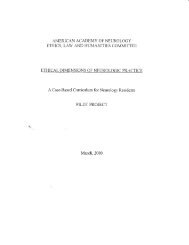

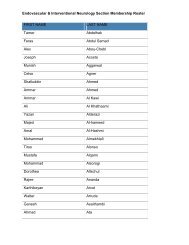
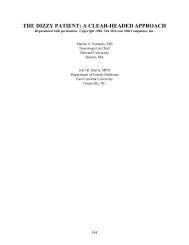

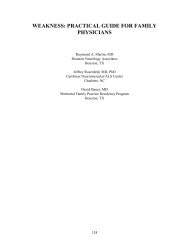
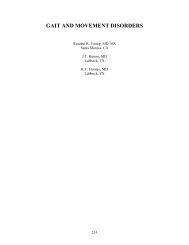
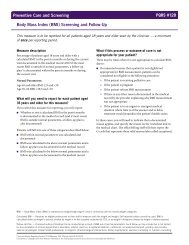
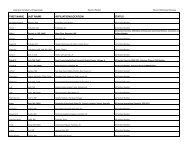
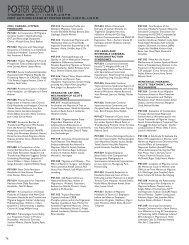
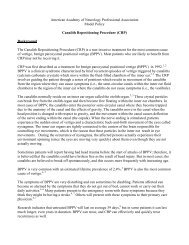
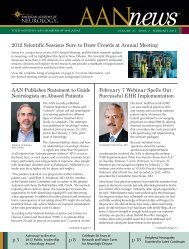
![[Click here and type date] - American Academy of Neurology](https://img.yumpu.com/8582972/1/190x245/click-here-and-type-date-american-academy-of-neurology.jpg?quality=85)
